Calorimetric Behaviour of Electric Cables
Abstract
1. Introduction
2. Basics of Quintiere’s Theory
3. Characteristic of Test Methods and Cable Samples
4. Cone Calorimeter Test Results and Discussion
5. Thermal Decomposition Processes on PVC Cable Combustible Elements (Supplement on the Analysis Performed)
6. Summary and Conclusions
- The analysis for cone calorimeter tests on electric cables based on Quintiere’s theory proved that it is possible to replace large geometric scale fire tests with a simpler cone calorimeter method. Therefore, the obtained data from tests on a cone calorimeter can be used as input data for numerical modelling of cable fires, thus reducing the cost and time constraints of the real scale experiments.
- An excellent correlation has been found between cone calorimeter test results (THR) modified by means of the experimental formula (MTHR) with semi-real scale experiment results (THR) for the cables burning completely.
- The presented research has shown that the thermally thin material approach can also be applied to more complex multi-layered products, for instance, electric cables.
- The obtained cone calorimeter results for PVC electric cable confirmed a strong relationship between fire properties and the incident radiant heat flux.
- HCl particles are released in the first phase of combustion at temperatures as low as 270–280 °C, as indicated by the results of the thermogravimetric analysis. The use of PVC-based cables is a potential fire safety hazard due to the emission of heat and a large amount of acid smoke containing HCl particles, which irritating people’s respiratory systems, obstruct the evacuation, and destroy electronic devices by corrosion processes.
Author Contributions
Funding
Institutional Review Board Statement
Informed Consent Statement
Acknowledgments
Conflicts of Interest
References
- International Organization for Standardization. ISO 5660-1:2015 Reaction-to-Fire Tests-Heat Release, Smoke Production and Mass Loss Rate-Part 1: Heat Release Rate (Cone Calorimeter Method) and Smoke Production Rate (Dynamic Measurement); International Organization for Standardization: Geneva, Switzerland, 2015. [Google Scholar]
- Carcillo, M.; Caro, A.-S.; Sonnier, R.; Ferry, L.; Gesta, E.; Lagrève, C. Fire behaviour of electrical cables in cone calorimeter: Influence of cables structure and layout. Fire Saf. J. 2018, 99, 12–21. [Google Scholar]
- Matala, A.; Hostikka, S. Probabilistic simulation of cable performance and water based protection in cable tunnel fires. Nucl. Eng. Des. 2011, 241, 5263–5274. [Google Scholar] [CrossRef]
- Fontaine, G.; Ngohang, F.-E.; Gay, L.; Bourbigot, S. Investigation of the Contribution to fire of Electrical Cable by a Revisited Mass Loss Cone. In Fire Science and Technology 2015; Springer: Singapore, 2017; pp. 687–693. [Google Scholar]
- Quintiere, J.G. A theoretical basis for flammability properties. Fire Mater. 2006, 30, 175–214. [Google Scholar] [CrossRef]
- Quintiere, J.G. Fundamentals of Fire Phenomena; John Wiley & Sons Ltd.: Hoboken, NJ, USA, 2006; ISBN-13 978-0-470-09113-5 (HB). [Google Scholar]
- Fernandez-Pello, A.C.; Hasegawa, H.K.; Staggs, K.; Lipska-Quinn, A.E.; Alvares, N.J. A Study of the Fire Performance of Electrical Cables. Fire Saf. Sci. 1991, 3, 237–247. [Google Scholar] [CrossRef]
- Meinier, R.; Sonnier, R.; Zavaleta, P.; Suard, S.; Ferry, L. Fire behavior of halogen-free flame retardant electrical cables with the cone calorimeter. J. Hazard. Mater. 2018, 342, 306–316. [Google Scholar] [CrossRef] [PubMed]
- Jianmin, Q. Prediction of Flame Spread Test Results from the Test Data of the Cone Calorimeter; Report SP 1990: 38; Statens Provningsanstalt: Boras, Sweden, 1990. [Google Scholar]
- Alpert, R.L.; de Ris, J. Summaries of Centre for Fire Research In-House Projects and Grants-1989; NIST IR 89-4188; National Institute For Standards and Technology: Gaithersburg, MD, USA, 1989; p. 81. [Google Scholar]
- Quintiere, J.G. How To Engineer A Material Fire Test. In Proceedings of the 11th Mediterranean Symposium of Combustion, Tenerife, Spain, 16–20 June 2019. The Spanish Section of Int., Combustion Institute, Spain. [Google Scholar]
- Quintiere, J.G.; Lian, D. Inherent flammability parameters-Room corner test application. Fire Mater. 2009, 33, 377–393. [Google Scholar] [CrossRef]
- Kaczorek-Chrobak, K.; Fangrat, J. Influence of constructional-material parameters on the fire properties of electric cables. Energies 2019, 12, 4569. [Google Scholar] [CrossRef]
- Kaczorek-Chrobak, K. Electric Cables Used in Buildings—Dependency of Fire Properties on Constructional and Material Parameters. Ph.D. Thesis, Instytut Techniki Budowlanej, Warsaw, Poland, 2020. [Google Scholar]
- Fangrat, J.; Hasemi, Y.; Yoshida, M.; Hirata, T. Surface temperature at ignition of wooden based slabs. Fire Saf. J. 1996, 27, 249–259. [Google Scholar] [CrossRef]
- Gandhi, P.; Przybyla, L.; Grayson, S.J. Electric Cables Applications. In Heat Release in Fires; Babrauskas, V., Grayson, S.J., Eds.; Elsevier Applied Science: London, UK, 1992; pp. 545–563. [Google Scholar]
- Kaczorek-Chrobak, K.; Fangrat, J. PVC-based copper electric wires under various fire conditions: Toxicity of fire effluents. Materials 2020, 13, 1111. [Google Scholar] [CrossRef] [PubMed]
- Kaczorek-Chrobak, K. Reakcja na ogień kabli bezhalogenowych oraz kabli na bazie PVC (Reaction to fire of PVC-based and halogen-free electric cables). Elektroinfo 2015, 10, 25–27. [Google Scholar]
- Kaczorek-Chrobak, K. Toksyczne produkty spalania izolacji i powłok kabli elektroenergetycznych. (Toxic combustion products of insulations and outer sheaths of cables.). Elektroinfo 2015, 5, 24–27. (In Polish) [Google Scholar]
- Fangrat, J. Combustibility of building products versus fire safety. Bull. Pol. Acad. Sci. Tech. Sci. 2016, 64. [Google Scholar] [CrossRef]
- Fangrat, J. On non-combustibility of commercial building materials. Fire Mater. 2017, 99–110. [Google Scholar] [CrossRef]




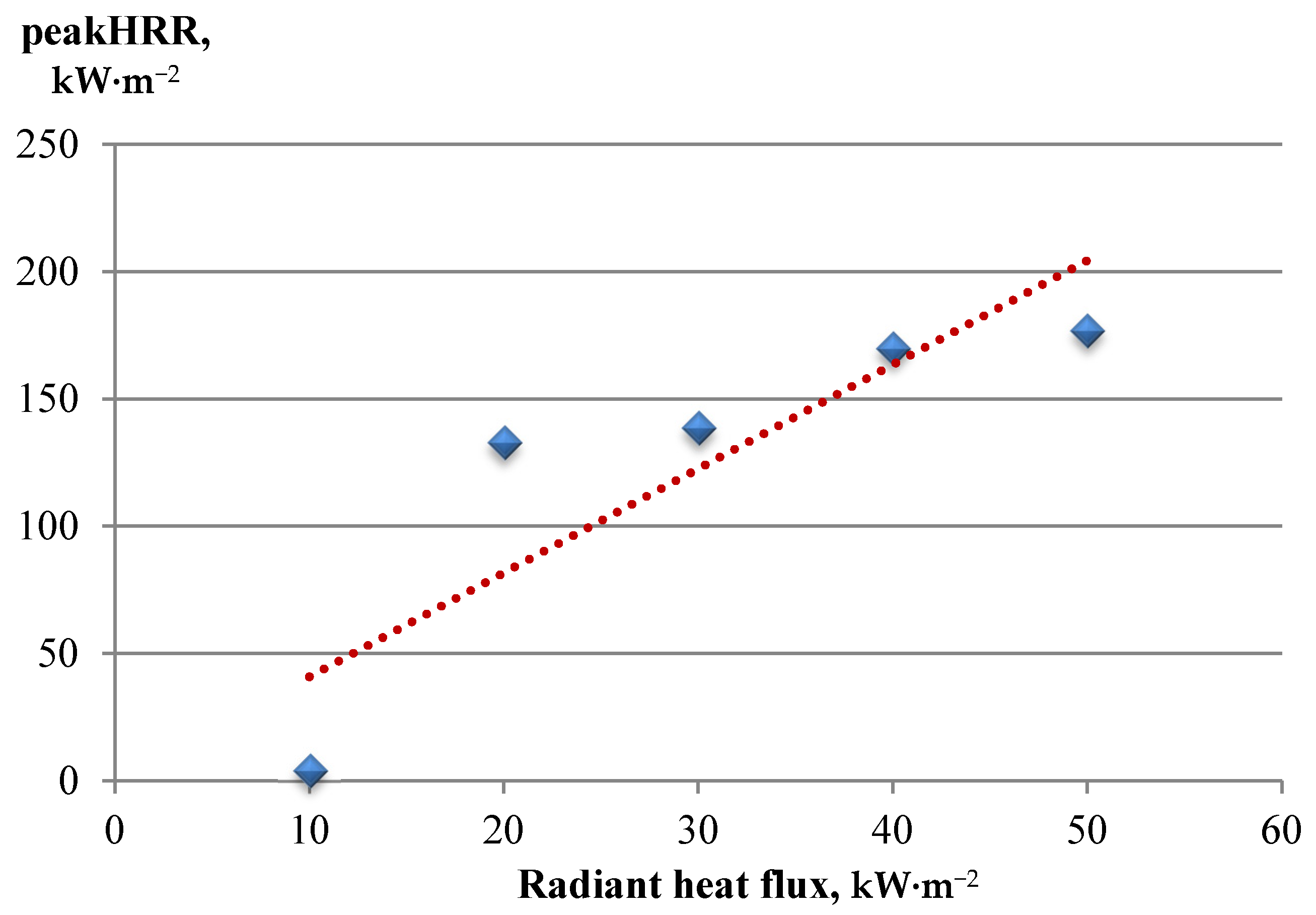
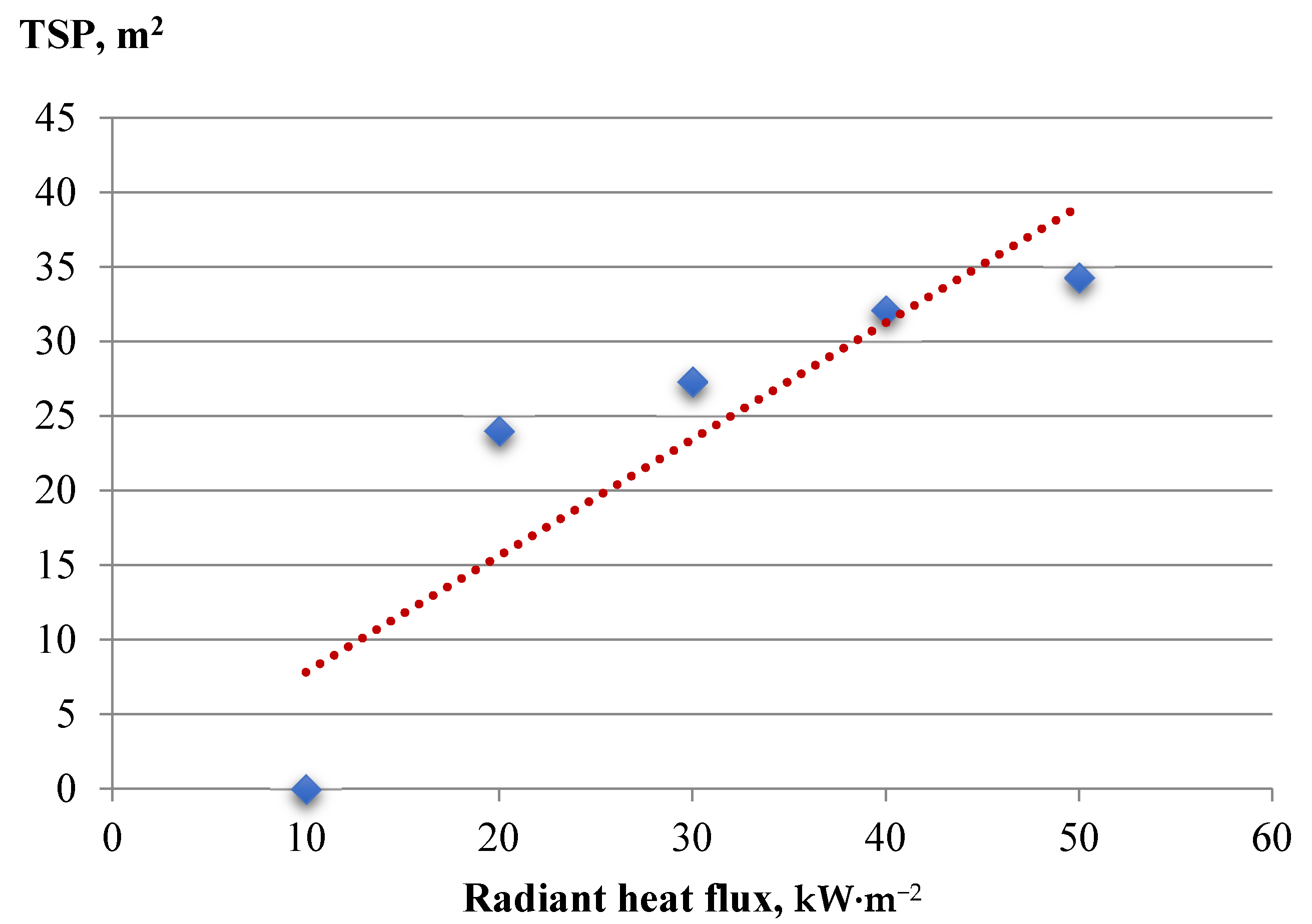
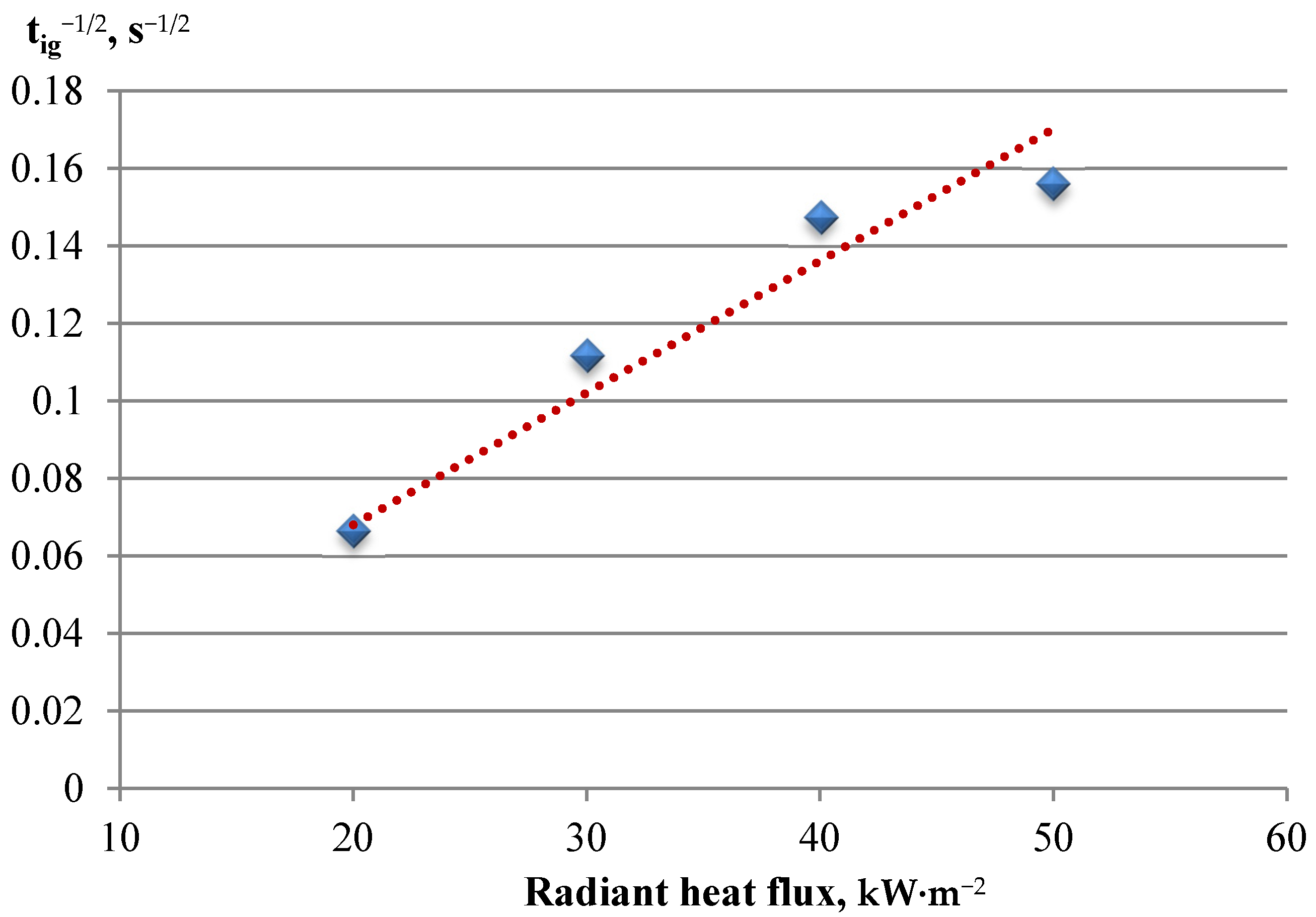
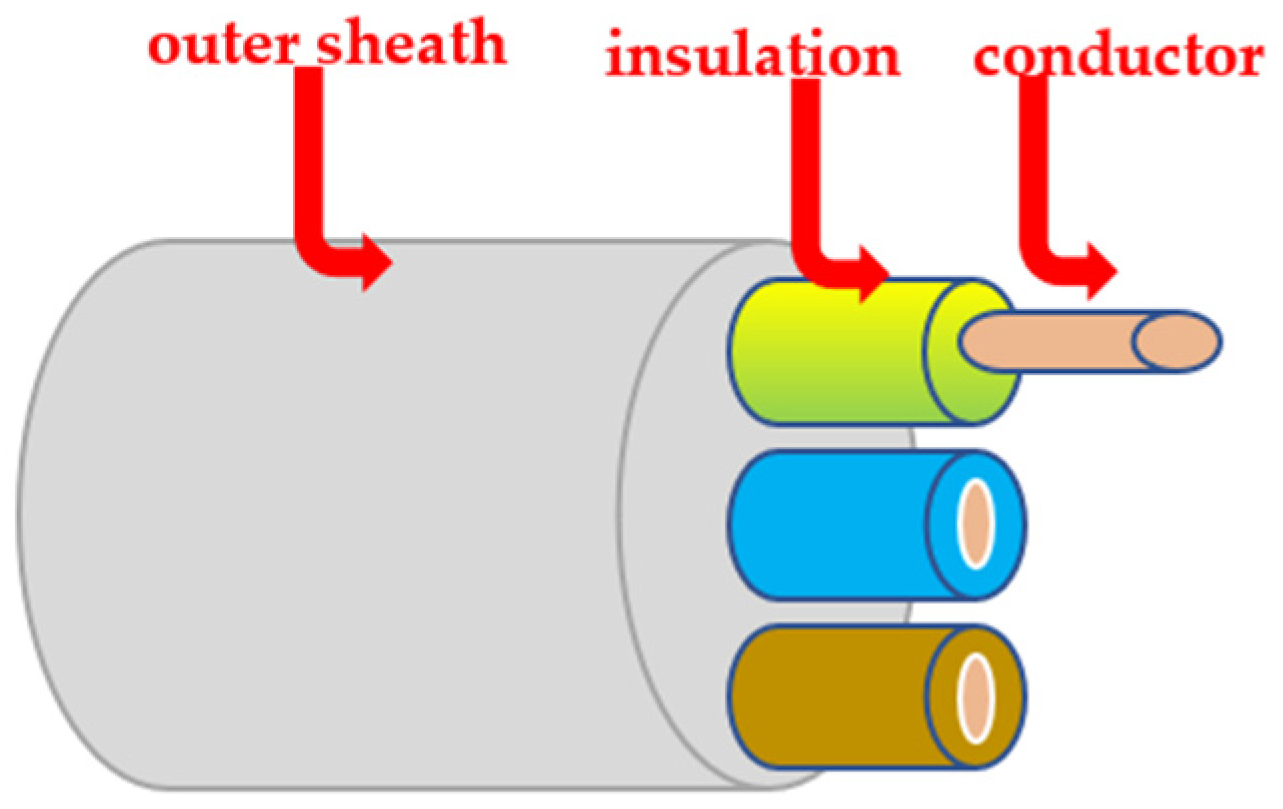

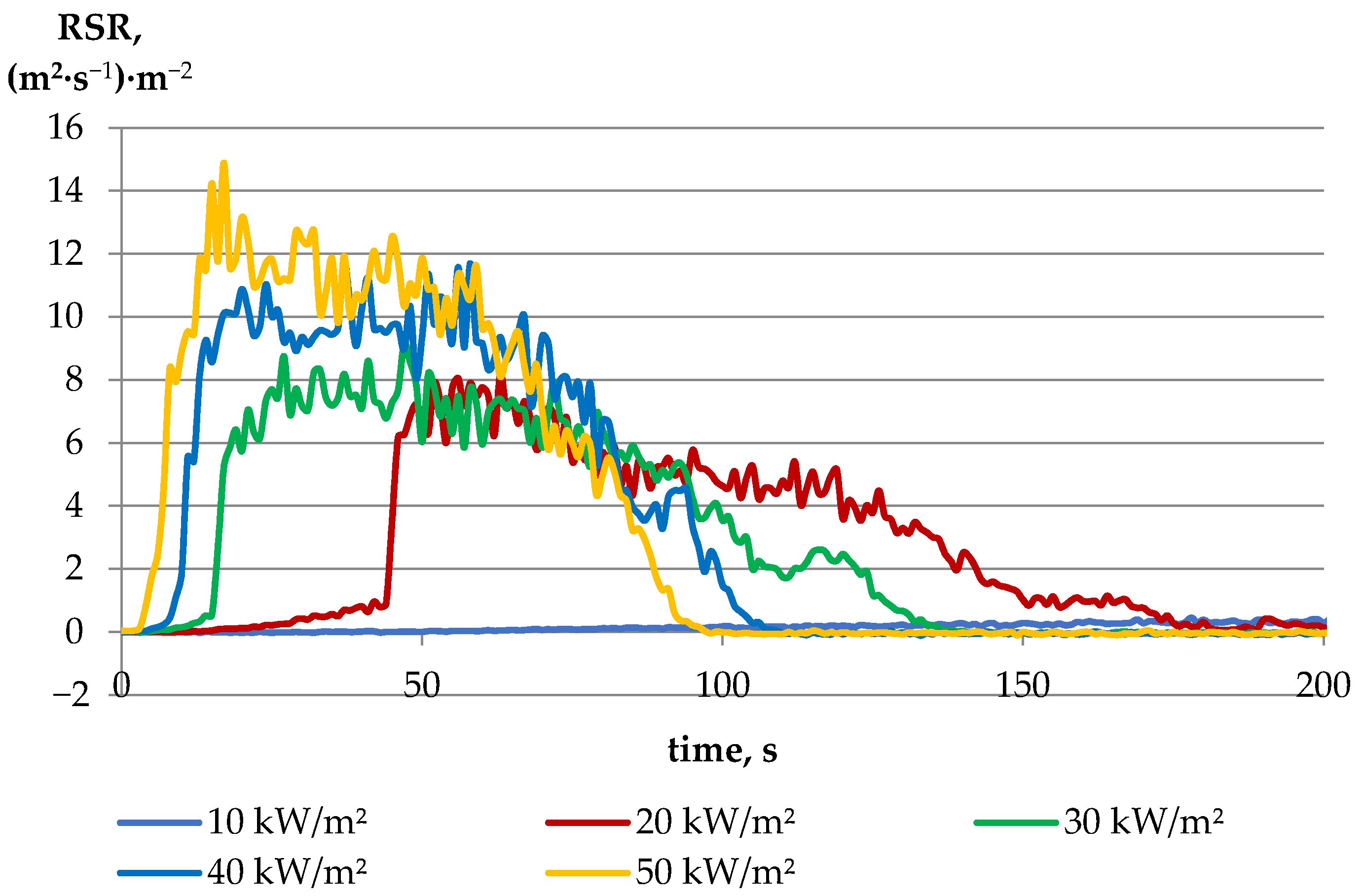
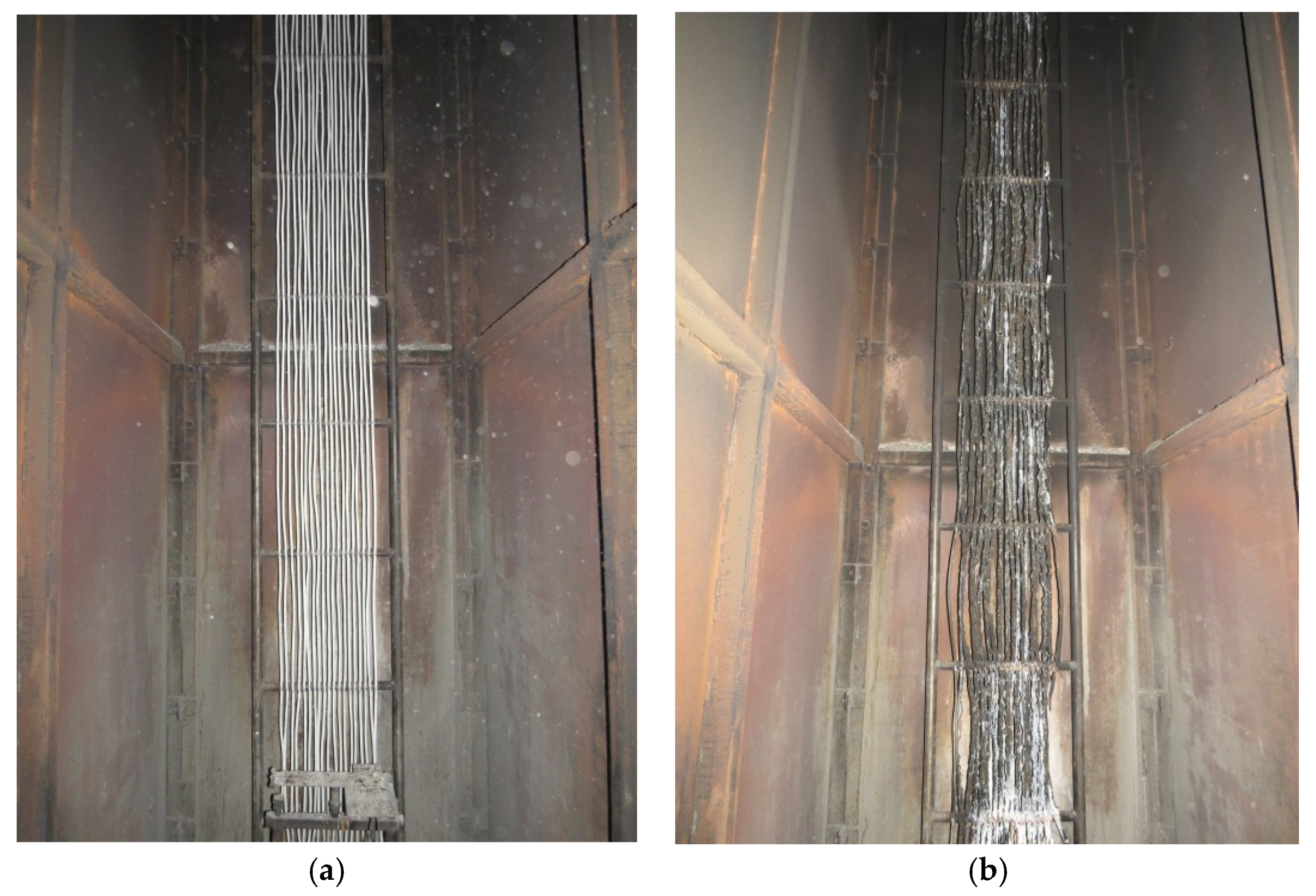
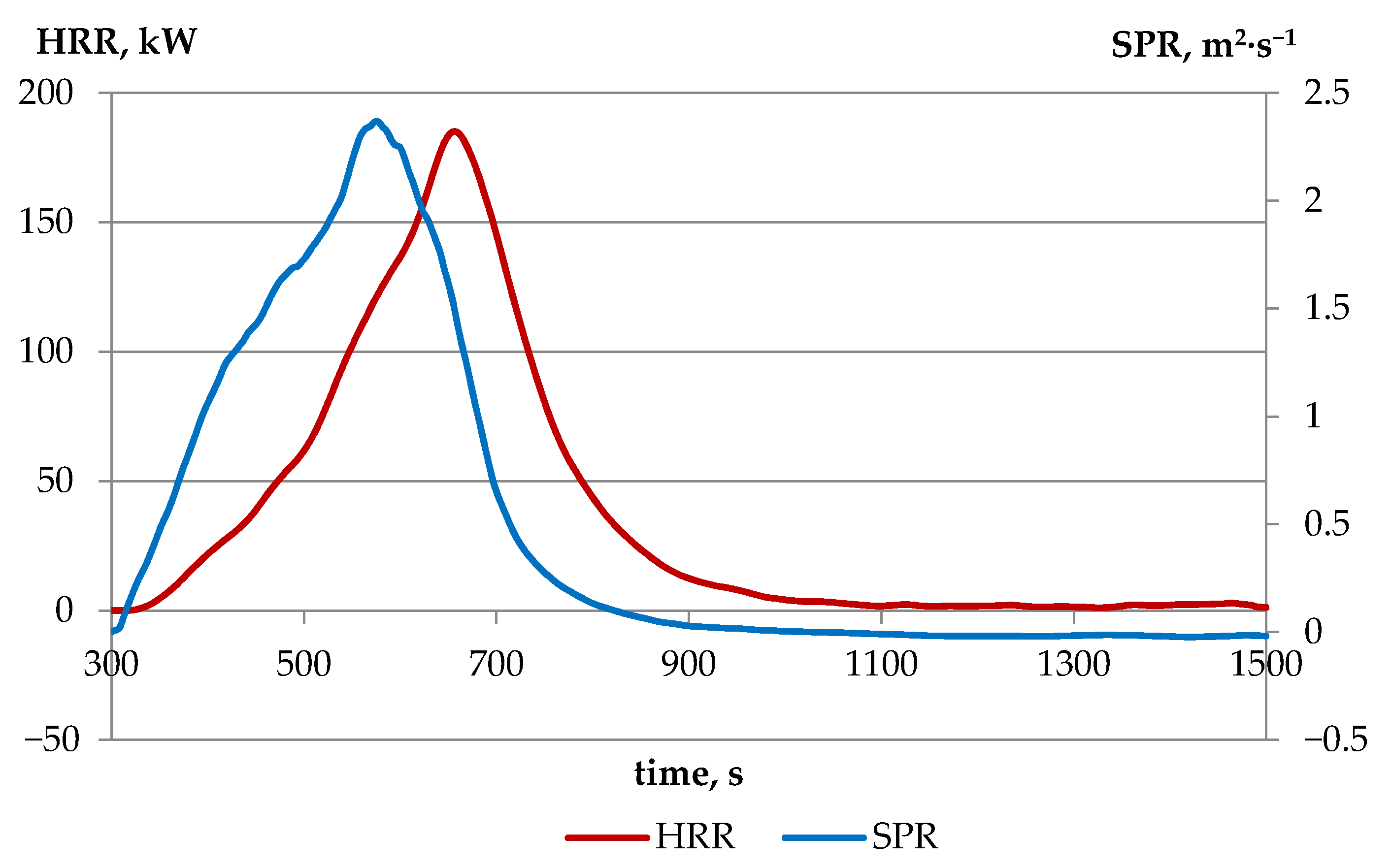
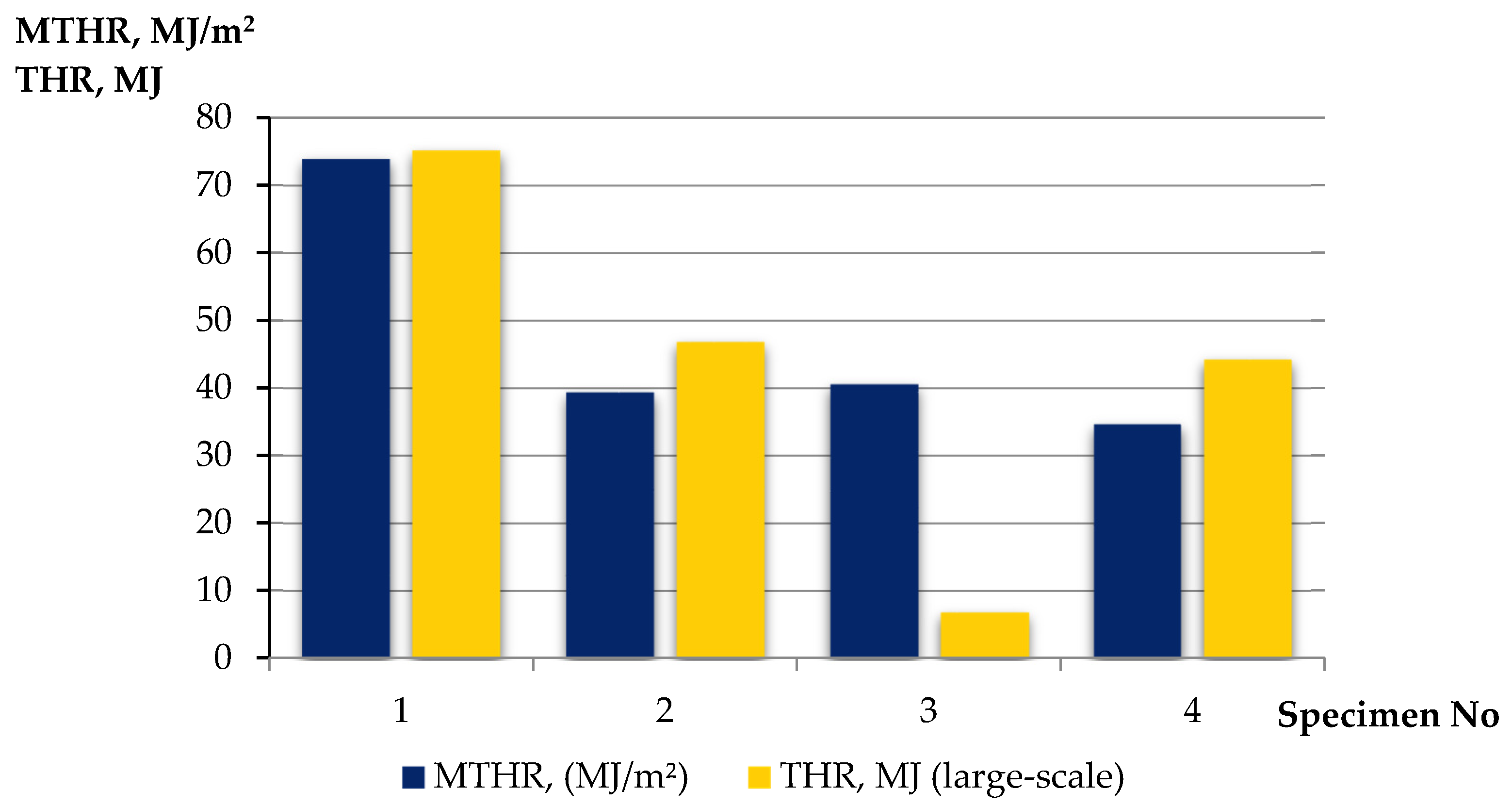

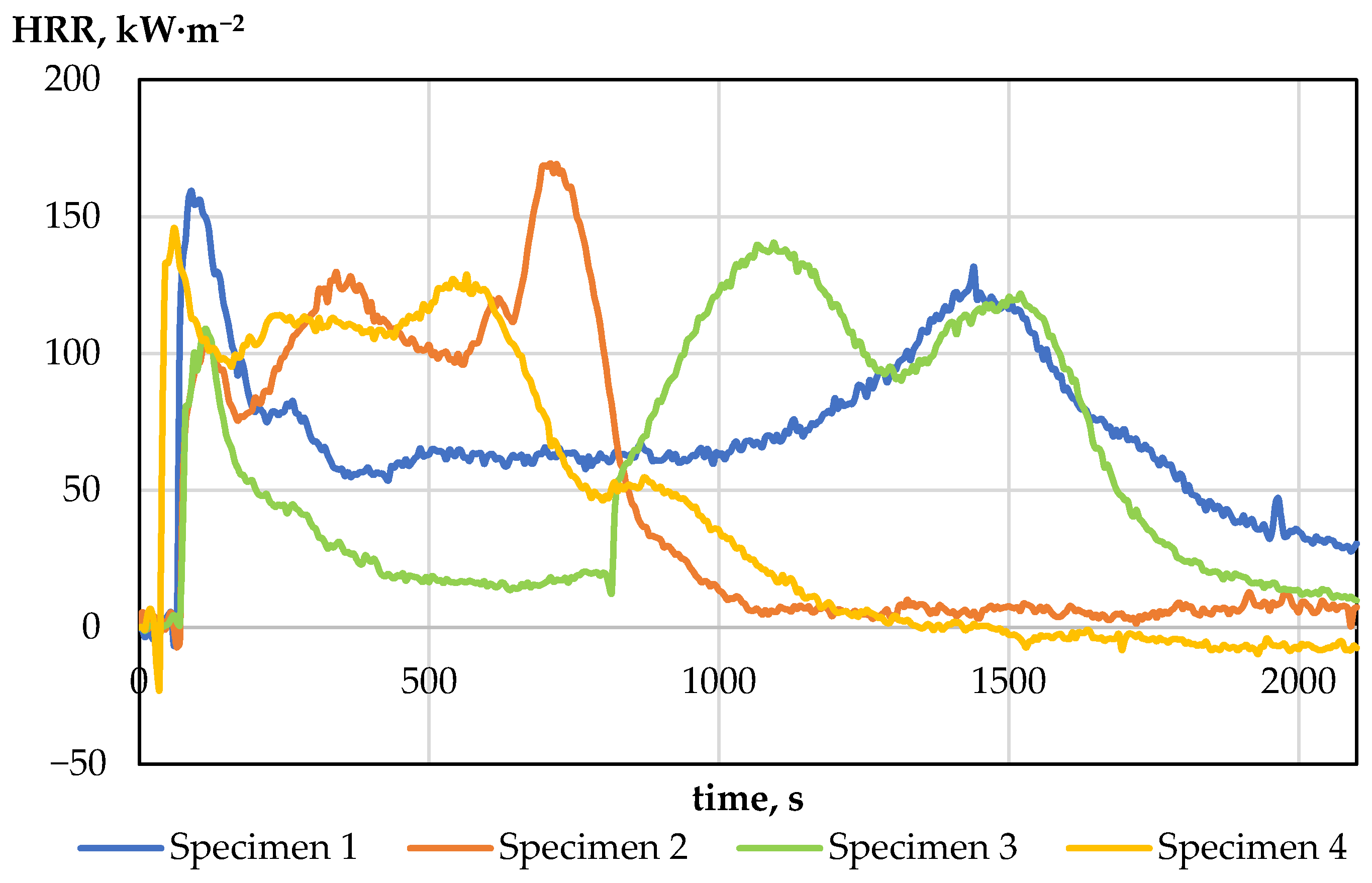

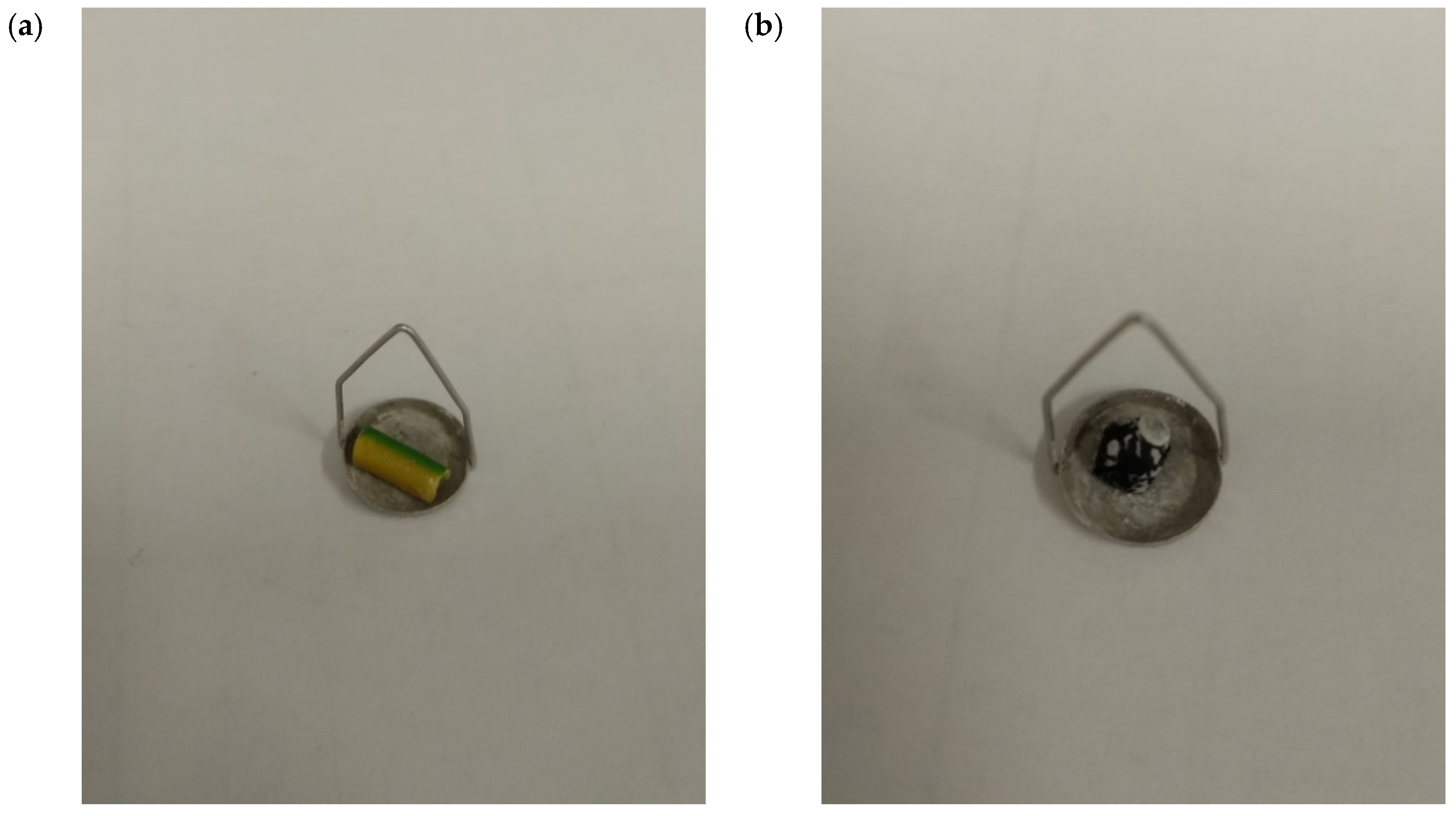
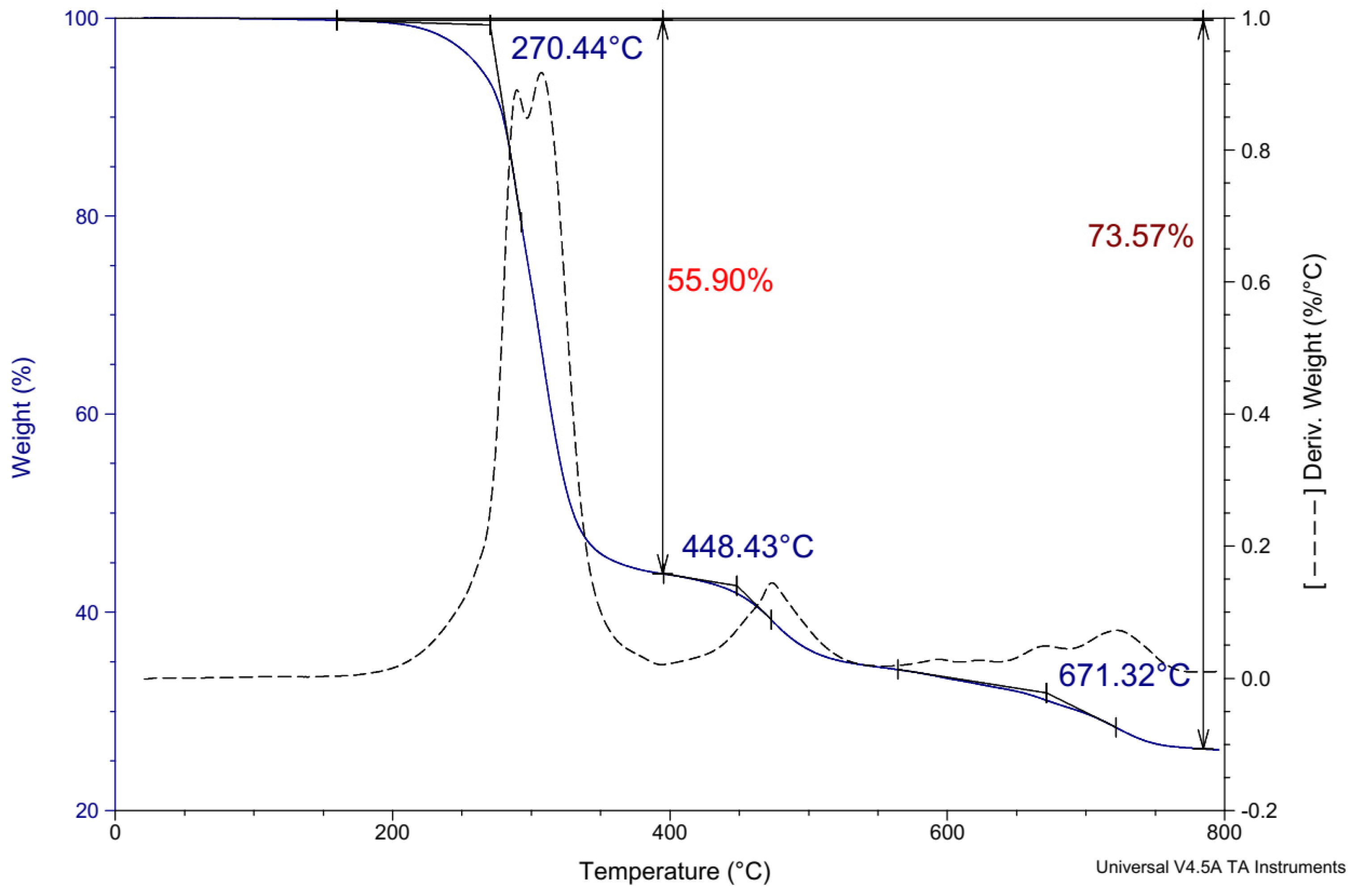
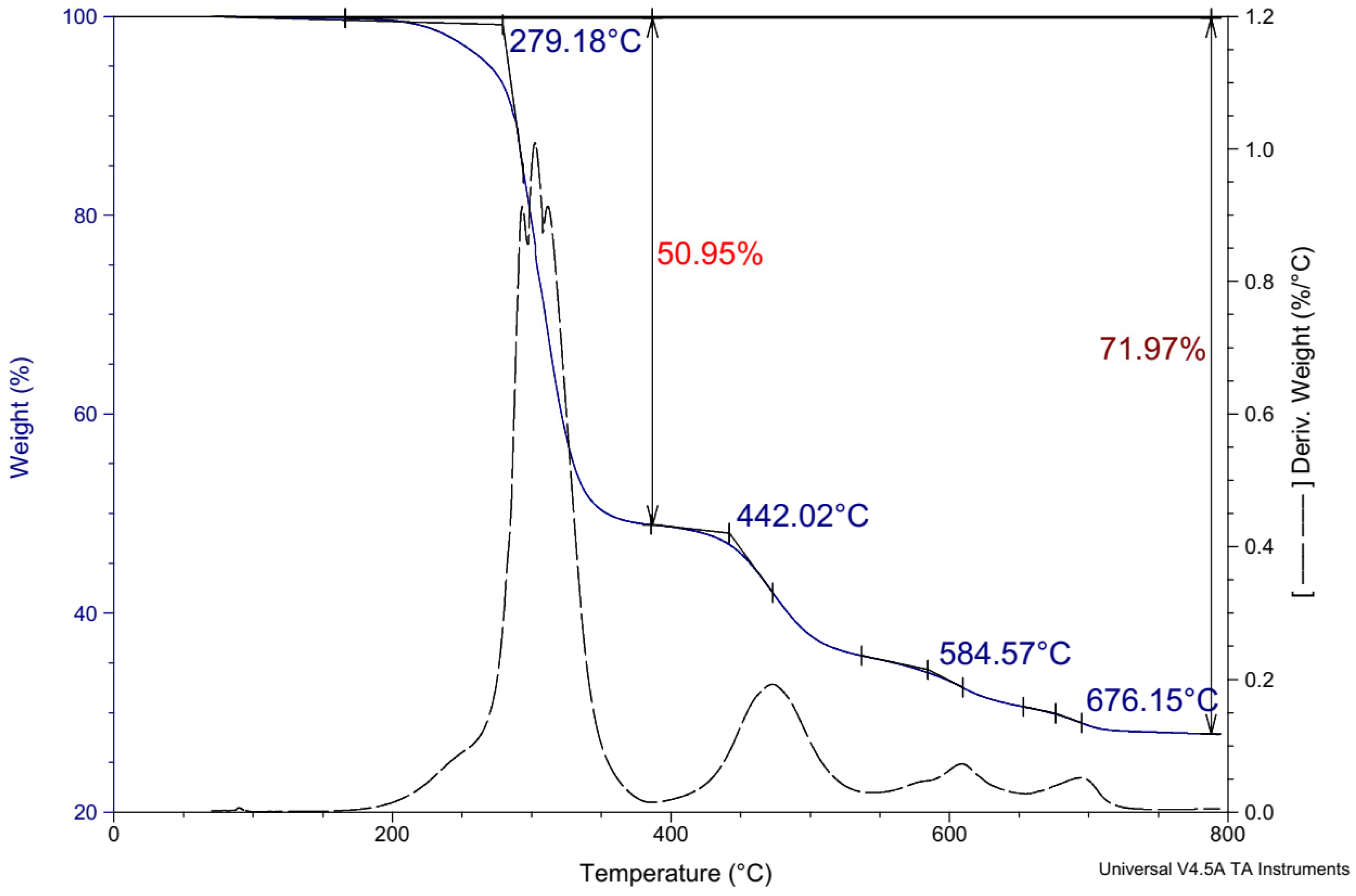
| Parameter | Physical Meaning | Measurement Means |
|---|---|---|
| TRP Thermal Response Parameter (C1 in Equation (2)) | For a given heat flux, TRP2 is directly proportional to the ignition time | Inverse slope of tig−1/2 and applied heat flux |
| CHF Critical Heat Flux | Proportional to ignition temperature, and is the minimum heat flux needed for ignition | Proportional to ignition temperature, and is the minimum heat flux needed for ignition |
| HRP Heat Release Parameter | Heat of combustion/Heat of gasification | Slope of maximum heat release rate (peak HRR) and heat flux |
| Specimen No | Type of Cable | Cable Size | Cable Dimensions, mm2 or (mm × mm) | Weight of Cable, kg·km−1 | Conductors | Insulations | Outer Sheath |
|---|---|---|---|---|---|---|---|
| 1 | optical fibre cable, non-halogenated | 48 J | 13.2 | 71 | Optical fibre | LS0H compound | LS0H compound |
| 2 | coaxial power cable, non-halogenated | 3 × 1 mm2 | 5.1 × 9.6 | 82 | Copper, round | XLPE | LS0H compound |
| 3 | copper control cable, non-halogenated | 16 × 0.5 mm2 | 11.1 | 192 | Copper, round | LS0H compound | LS0H compound |
| 4 | coaxial power cable, halogenated | 3 × 1.5 mm2 | 3.8 × 8.5 | 76 | Copper, round | PVC | PVC |
| Specimen No | Cable Size | Cable Dimensions, mm × mm | Weight of Cable, kg·km−1 | Conductors | Insulations | Outer Sheath | Heat Flux, kW·m−2 |
|---|---|---|---|---|---|---|---|
| 1 | 3 × 1.5 mm2 | 3.8 × 8.5 | 76 | Copper, round | PVC | PVC | 10 |
| 2 | 20 | ||||||
| 3 | 30 | ||||||
| 4 | 40 | ||||||
| 5 | 50 |
| Specimen No. | Heat Flux, kW·m−2 | tig, s | tig−1/2, s−1/2 | peakHRR, kW·m−2 | TSP, m2 | Δm, g |
|---|---|---|---|---|---|---|
| 1 | 10 | no ignition | n/a | 3.94 | 0 | 0.35 |
| 2 | 20 | 226 | 0.07 | 132.89 | 24 | 46.30 |
| 3 | 30 | 80 | 0.11 | 138.7 | 27.3 | 47.29 |
| 4 | 40 | 46 | 0.15 | 169.78 | 32.1 | 46.44 |
| 5 | 50 | 41 | 0.16 | 176.84 | 34.3 | 46.57 |
| Specimen No. | Cone Calorimeter | Large-Scale | |||||||||
|---|---|---|---|---|---|---|---|---|---|---|---|
| tig, s | peakHRR, kW·m−2 | THR, MJ·m−2 | TSP, m2 | TSR, m2·m−2 | Δm, | MTHR, MJ·m−2 | peakHRR, kW | THR, MJ | TSP, m2 | Flame Spread (FS), m | |
| 1 | 60 | 159.41 | 139.7 | 7.3 | 825.8 | 0.53 | 73.9 | 163.95 | 75.17 | 35 | 3.50 |
| 2 | 66 | 169.38 | 94.7 | 12.6 | 1423.4 | 0.42 | 39.3 | 91.6 | 46.83 | 86 | 3.50 |
| 3 | 58 | 140.53 | 121 | 21.4 | 2419.8 | 0.33 | 40.5 | 20.76 | 6.78 | 13 | 0.64 |
| 4 | 21 | 145.79 | 93 | 34.5 | 3899.3 | 0.37 | 34.6 | 185.11 | 44.19 | 598 | 3.50 |
Publisher’s Note: MDPI stays neutral with regard to jurisdictional claims in published maps and institutional affiliations. |
© 2021 by the authors. Licensee MDPI, Basel, Switzerland. This article is an open access article distributed under the terms and conditions of the Creative Commons Attribution (CC BY) license (http://creativecommons.org/licenses/by/4.0/).
Share and Cite
Kaczorek-Chrobak, K.; Fangrat, J.; Papis, B.K. Calorimetric Behaviour of Electric Cables. Energies 2021, 14, 1007. https://doi.org/10.3390/en14041007
Kaczorek-Chrobak K, Fangrat J, Papis BK. Calorimetric Behaviour of Electric Cables. Energies. 2021; 14(4):1007. https://doi.org/10.3390/en14041007
Chicago/Turabian StyleKaczorek-Chrobak, Katarzyna, Jadwiga Fangrat, and Bartłomiej K. Papis. 2021. "Calorimetric Behaviour of Electric Cables" Energies 14, no. 4: 1007. https://doi.org/10.3390/en14041007
APA StyleKaczorek-Chrobak, K., Fangrat, J., & Papis, B. K. (2021). Calorimetric Behaviour of Electric Cables. Energies, 14(4), 1007. https://doi.org/10.3390/en14041007






